Lepinja, or Somun, is a soft and fluffy bread from the Balkans in Southeastern Europe that makes the perfect accompaniment to any meal.
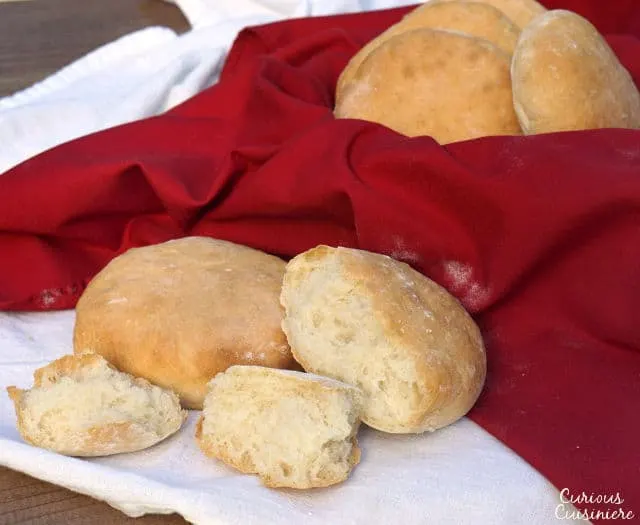
Lepinja, also known as Somun, is a popular street food in the Balkans region, particularly Serbia, Bosnia, and Croatia. It is sometimes known as lepinje za cevapi, because it is most commonly served with cevapi grilled sausages.
It is a soft and light bread with a very mild flavor, so no matter what you serve it with, it takes on the flavors of the dish, adding a wonderful, soft and comforting texture.
Triple Rise Flatbread
What makes lepinja very unique is the triple rise. This creates a very tender and soft bread that looks like pita, but has a texture that more closely resembles a soft focaccia. Using milk instead of water also contributes to the creamy flavor and texture of this bread.
Lepinja: A Daily Bread
This is a daily bread in the Balkans, and is definitely one of those breads that is best the day it is made. Hot out of the oven, or even later that day, its soft and creamy texture are captivating.
Lepinja will stay good for 2 or 3 days in an airtight container on the counter. But after that, it will starts to dry out. That is why our recipe only makes a few individual serving breads.
We’re glad it is such a simple and hands-off bread to make, so it is an easy one to make often!
The trick to Making Lepinja
While it is sometimes called a flatbread, lepinja is fluffy and can be a bit more lofty than you would typically think of for a flatbread.
Lepinja starts off baking at a very high temperature, like pita bread.
If your oven temperature is hot enough and you are lucky, your lepinja might even get an air pocket that creates a slightly hollowed center pocket (or simply a separation), like pitas.
Unfortunately, ours didn’t create a pocket. But the bread still tasted wonderful and great for splitting with a knife and stuffing with our fillings.
It is also fantastic served with Ajvar, a roasted red pepper and eggplant spread from the Balkans. Once you try this combo, you might never go back to your standard bread and butter!
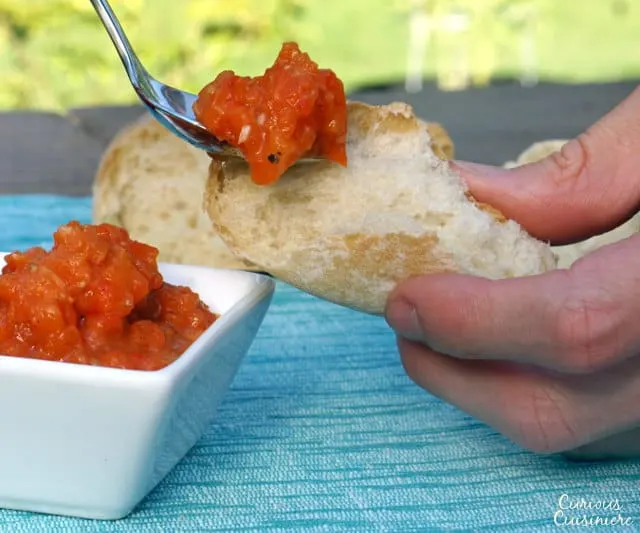
Lepinja (Balkan Flatbread)
Ingredients
- 2 Tbsp milk, warmed to 80-90⁰F
- 2 ¼ tsp active dry yeast (1 package)
- 1 c water
- 1 tsp sugar
- 3 c unbleached all purpose flour
- 1 tsp salt
Instructions
- Place the warm milk in a large bowl. Sprinkle the yeast over the milk and let it stand until softened and foamy, 5 min.
- Add the water and sugar to the milk and yeast. Mix to combine.
- Add the flour and salt, mixing until a soft dough comes together. Turn the dough out on a lightly floured surface and knead for 5-7 minutes by hand (or 2-3 minutes in a stand mixer fitted with a dough hook), until the dough is smooth but still slightly sticky.
- Shape the dough into a ball and place it into a clean bowl. Cover the bowl with a damp tea towel and let the dough rise in a warm and draft-free place until doubled, roughly 1 hour.
- Once the dough has risen, punch it down. Re-cover it with the damp tea towel and let rise a second time, until doubled, roughly 1 hour.
- Punch down the dough a second time and divide it into 6 portions. Shape each portion into a ball. Place the balls onto a lightly floured surface, cover them with the damp tea towel, and let them rest for 5-10 minutes.
- After resting, flatten the balls into discs that are ½ inch thick. Place the flattened rounds on to a floured baking sheet. Cover them with the damp tea towel and let them rise for 20 minutes.
- While the bread is rising this final time, preheat your oven to 450⁰F.
- Once risen, uncover the dough, place the baking sheet into oven, and bake for 5-7 minutes, until the breads are just starting to turn golden.
- Lower the heat to 300⁰F and bake for another 7-10 minutes, until evenly golden.
- Remove the lepinja from oven and wrap them in a (dry) tea towel for 10 minutes to soften the crust.
- Slice the lepinja open to serve, if desired. Serve warm.
- The bread will keep on the counter for 2-3 days.
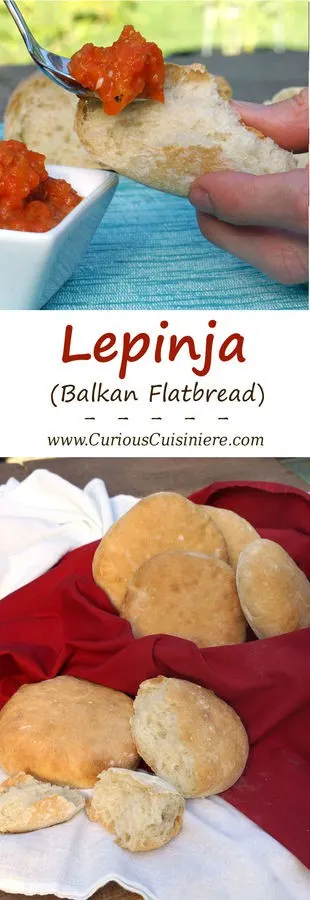
If you liked this recipe, here are some similar dishes you may enjoy!

Sarah founded Curious in 2010 as a way to save her recipe creations and share culinary experiences. Her love for cultural cuisines was instilled early by her French Canadian Grandmother. Her experience in the kitchen and in recipe development comes from over 10 years working in professional kitchens. She has traveled extensively and enjoys bringing the flavors of her travels back to create easy-to-make recipes.
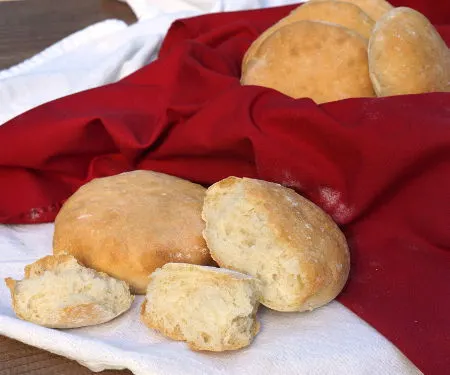
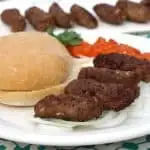
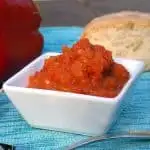
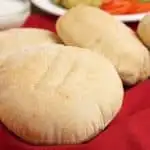
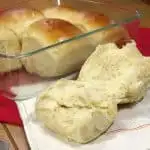



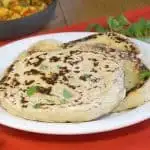
Vincent Degiorgio
Sunday 4th of December 2022
Hi Sarah I am having a lot of trouble balancing the milk with the amount of yeast that I am asked to proof here. 2 tablespoons, or 56 mL of milk in a large bowl, essentially makes any yeast you put into it instantly start to crumble if I’m doing this wrong, just let me know. I love the recipe and I’ve made it a number of times but this is a problem for me.
Sarah - Curious Cuisiniere
Monday 12th of December 2022
Hi Vincent. I'm not sure what you mean by the yeast starts to 'crumble'. (I've never seen an issue of this nature with active dry yeast.) If you could elaborate, I could try to help a bit more. However, 2 Tbsp of milk should be closer to 29.5 mL, so maybe that will help.
Anka
Sunday 24th of April 2022
I make these with cevapi and they are perfect. Will make these again for sure!
Sarah Ozimek
Sunday 24th of April 2022
So glad you enjoy them!
Vincent Degiorgio
Sunday 10th of October 2021
I tried three or four different recipes to make this Croatian flatbread and yours by far came out the best. It is now our go to. Thanks!
Sarah Ozimek
Tuesday 12th of October 2021
So glad you enjoy it!
Mark
Friday 29th of January 2021
Hello Sarah, Thanks for the recipe. I love to make Cevapi and Balkin stores are hard to find in my area. So to save myself a 60mi, round trip I decided to give this a try. Turned out fantastic! I didnt get a pocket either, but the family were impressed. This was the first time Ive made bread. So I have a few questions for you. 1. When you say punch down, I assume you mean the traditional definition of punching it down and re rolling into a ball to let it rise again? 2. When flattening the balls before baking, I used a flat surface to just push them flat. Would it have been better to just gently use my finger tips to keep more air in the dough? Last I was a little concerned that after 7min @ 450, they didnt start to get golden at all. After 10min @ 300, they were just starting to get golden. I pulled them out worried they would burn on the bottom. They were still fully cooked and fluffy on the inside but never really got the attractive browning. Any suggestions?
Thanks!!
Sarah Ozimek
Saturday 30th of January 2021
Hi Mark. Glad you enjoyed the bread! 1. Yes, 'punch down' is to deflate it from its rise. The first time you re-roll to let rise again. The second time, you divide it and shape it. 2. Either is fine. I typically use my finger tips, but using a flat surface would result in a more even top to the dough. 3. As to the browning, I wonder where your oven rack was positioned. If it was too far from the heating element, that could have impacted the rate of browning. Another way to help the browning would be to brush them with a little milk before putting them into the oven.
Anka
Tuesday 19th of January 2021
My husband grew up eating this bread. He always asked me to make it. Finally found a recipie that he likes. Thank you for sharing.
Sarah Ozimek
Wednesday 20th of January 2021
So glad you found us!